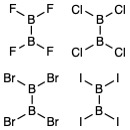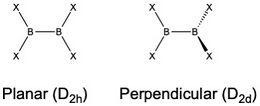Chemistry:Tetrahalodiboranes
Tetrahalodiboranes are a class of diboron compounds with the formula [math]\ce{ B2X4 }[/math] (X = F, Cl, Br, I). These compounds were first discovered in the 1920s,[1] but, after some interest in the middle of the 20th century, were largely ignored in research. Compared to other diboron compounds, tetrahalodiboranes are fairly unstable and historically have been difficult to prepare; thus, their use in synthetic chemistry is largely unexplored, and research on tetrahalodiboranes has stemmed from fundamental interest in their reactivity.[2] Recently, there has been a resurgence in interest in tetrahalodiboranes, particularly in diboron tetrafluoride as a reagent to promote doping of silicon with [math]\ce{ B+ }[/math]for use in semiconductor devices.[3]
Structure
Because the perpendicular and planar geometries of tetrahalodiboranes are generally very close in energy, the energetic difference between these two structures has been the most investigated aspect of the geometry of these molecules. As it turns out, the difference is dependent on the identity of the halide in the compound. [math]\ce{ B2F4 }[/math] adopts a planar geometry ([math]\displaystyle{ D_{2h} }[/math] symmetry) in both as a solid and in the gas phase. The barrier to rotation, however, is small (only 0.42 kcal/mo)l.[4][5] [math]\ce{ B2Cl4 }[/math], however, adopts a planar geometry when crystalized but favors the perpendicular geometry ([math]\displaystyle{ D_{2d} }[/math] symmetry) in the gas phase.[4][5] Computations of the relative stability of the two conformers indicate that the [math]\displaystyle{ D_{2d} }[/math] geometry is ~2kcal/mol lower in energy; the planar geometry in the solid phase is thought to be due to packing effects.[5] Continuing this trend, computational modeling and experimental results agree that [math]\ce{ B2Br4 }[/math] and [math]\ce{ B2I4 }[/math] favor the perpendicular [math]\displaystyle{ D_{2d} }[/math] geometry.[4][6]
Synthesis
The first synthesis of a tetrahalodiborane was reported by Stock et al. in 1925 where the authors reduced [math]\ce{ BCl3 }[/math]to form [math]\ce{ B2Cl4 }[/math] by running a current between zinc electrodes immersed in liquid [math]\ce{ BCl3 }[/math].[1] Later work explored gas phase syntheses of [math]\ce{ B2Cl4 }[/math] using gaseous [math]\ce{ BCl3 }[/math] and mercury electrodes.[7] Early characterization of [math]\ce{ B2Cl4 }[/math] reported the to be a colorless, pyrophoric liquid that decomposes at temperatures above 0 °C.[8] [math]\ce{ B2F4 }[/math] was not synthesized until 1958 when Finch and Schlesinger reported the successful synthesis of [math]\ce{ B2Cl4 }[/math] with antimony trifluoride to form [math]\ce{ B2F4 }[/math].[9] Unlike [math]\ce{ B2Cl4 }[/math], [math]\ce{ B2F4 }[/math] is stable at room temperature.[9] The heavier tetrahalodiboranes, [math]\ce{ B2Br4 }[/math] and [math]\ce{ B2I4 }[/math], were first published in 1949 by Schlesinger et al. and Schumb respectively.[10] [math]\ce{ B2Br4 }[/math] was first accessed by reacting [math]\ce{ B2Cl4 }[/math] and [math]\ce{ BBr3 }[/math].[10] [math]\ce{ B2I4 }[/math] was first synthesized using electrodeless radiofrequency discharge to reduce [math]\ce{ BI3
}[/math].[10] [math]\ce{ B2Br4 }[/math] is stable at temperatures below -40 °C, while [math]\ce{ B2I4 }[/math] is stable below 0 °C. [math]\ce{ B2I4 }[/math] also degrades when exposed to light.[11] Decomposition of [math]\ce{ B2I4 }[/math] at elevated temperatures yields a [math]\ce{ BI3 }[/math] and a black solid found to be a mixture of B
9I
9 and B
8I
8.[12]
The initial interest in tetrahaloiboranes was largely fundamental, and more applied consideration of tetrahalodiboranes was largely limited by the difficulty of synthesis and the low stability of isolated compounds. Recent improvements in the synthesis of tetrahalodiboranes has yielded more convenient solution phase syntheses of [math]\ce{ B2F4 }[/math], [math]\ce{ B2Cl4 }[/math], [math]\ce{ B2Br4 }[/math], and [math]\ce{ B2I4 }[/math].[3] The solution phase synthesis of [math]\ce{ B2Br4 }[/math] first reported by Noth et al in 1981 has not been improved upon. To form [math]\ce{ B2Br4 }[/math] in solution, [math]\ce{ B2(OMe)4 }[/math] is treated with [math]\ce{ BBr3 }[/math].[3] Other tetrahalodiboranes can be accessed from [math]\ce{ B2Br4 }[/math] in the solution phase by reacting with [math]\ce{ SbF3 }[/math], [math]\ce{ GaCl3 }[/math], or [math]\ce{ BI3 }[/math] to form [math]\ce{ B2F4 }[/math], [math]\ce{ B2Cl4 }[/math], or [math]\ce{ B2I4 }[/math] respectively.[3] These improvements in synthetic methods have opened the door for exploring potential applications of tetrahalodiboranes; while this interest has been fairly limited thus far, researchers have begun to explore the use of tetrahalodiboranes as synthetic building blocks and for use in industrial applications.[3] Notably, recent publications discussing tetrahalodiboranes have been largely in patent literature discussing the use of [math]\ce{ B2F4 }[/math] to replace [math]\ce{ BF3 }[/math] as a feed chemical to dope semiconductors with boron ions.[3]
Reactivity
Lewis base adduct formation
The boron atoms in tetrahalodiboranes are highly lewis acidic and readily form adducts with neutral lewis bases.[11] Though the formation of these complexes is usually energetically favorable, early attempts to form these lewis acid base complexes were hindered by the lability of the halogen substituents;[11] prior to the 1992 publication of three additional phosphane-tetrahalodiborane(4) adducts, only three lewis acid-lewis base adducts had been reported.[13] Other work has described many more lewis acid-lewis base adducts that form readily, but also outline how stability challenges with tetrahalodiboranes persist even in stabilized complexes.[11] Examples of these unstable tetrahalodiborane-lewis base adducts include the bis-diethyl ether adduct formed with [math]\ce{ B2Cl4 }[/math] or [math]\ce{ B2F4 }[/math], the bis-adduct of [math]\ce{ B2Cl4 }[/math] and either [math]\ce{ SH2 }[/math] or [math]\ce{ PH3 }[/math], and adducts formed by [math]\ce{ B2Cl4 }[/math] or [math]\ce{ B2F4 }[/math] and weak phosphine donors such as [math]\ce{ PCl3 }[/math] or [math]\ce{ PBr3 }[/math].[11]
There are, however, some adducts that are stable beyond room temperature. [math]\ce{ B2Cl4 }[/math] and [math]\ce{ B2F4 }[/math] both form stable mono- and bis-adducts with aprotic nitrogen donors.[11] The first of these stable lewis base-tetrahalodiborane adducts was published in 2012 by Braunshcweig et al. showing that [math]\ce{ B2Br4(IDip)2 }[/math] (where [math]\ce{ IDip }[/math]=1,3-bis(2,6-diisopropylphenyl)-imidazole-2-ylidene) is stable at ambient temperature. [math]\ce{ B2Br4(IDip)2 }[/math] could then be reduced to form [math]\ce{ B2Br2(IDip)2 }[/math], a stable diborene, and could ultimately be reduced further to form [math]\ce{ B2(IDip)2 }[/math] the first isolable diboryne.[11][14] Since this discovery, the Braunschweig group has published a number of other stable tetrahalodiborane adducts including some monoadducts and some asymetrical bis adducts. These adducts are typically characterized using [math]\ce{ ^{11}B }[/math] NMR.[11]
Reaction with transition metals
There has been some investigation of the reactivity of tetrahalodiboranes with transition metals. Norman et al. reported reactivity of [math]\ce{ B2F4 }[/math] with [math]\ce{ PtL2 }[/math] to form [math]\ce{ cis-[Pt(BF2)2L2] }[/math] where L
2=
2PPh
3, Ph
2P(CH
2)
4PPh
2.[3] Because the boron-halide bonds in B
2F
4 are substantially less reactive than in heavier tetrahalodiboranes, it is unsurprising that reactivity with Pt occurs at the B-B bond.[2]
Because it was expected that heavier tetrahalodiboranes might have more reactive boron-halide bonds, the reactivity of [math]\ce{ B2I4 }[/math] with electron rich [math]\ce{ Pt(PCy3)2 }[/math] was explored.[2] The greater lability of the [math]\ce{ B-I }[/math] bond relative to the [math]\ce{ B-F }[/math] bond in [math]\ce{ B2F4 }[/math] allowed for the formation of a diplatnum complex with borryl ligands and a bridging [math]\ce{ [B2I4] }[/math].[2]
Reaction with boriranylideneboranes
In 2001, Seibert et al. showed that three boriranylideneboranes first synthesized by Berndt et al. in the 1980s could be reacted with tetrahalodiboranes to yield interesting boron containing compounds shown in the scheme below.[15] In the first reaction, both the chlorine and fluorine containing compounds were synthesized in good yields, but the fluorine compound was noticeably less stable. The all compounds shown below were characterized by 11B,1H and 13C NMR.
Addition to unsaturated hydrocarbons
Tetrahalodiboranes can add to unsaturated hydrocarbons. Schlesinger et al. published 1,2-additions of [math]\ce{ B2Cl4 }[/math] to ethylene and acetylene.[16] Later work explored the reactivity of [math]\ce{ B2Cl4 }[/math] with other alkenes, alkynes and dienes and showed that [math]\ce{ B2F4 }[/math] can react similarly.[5] [math]\ce{ B2Br4 }[/math]can also add to alkenes.[5] In 2015, Brown et al. used electronic structure calculation to provide mechanistic information on some of these (uncatalyzed) boron additions. Most interestingly, the authors were able to provide mechanistic information explaining the stereospecificity of the reaction of [math]\ce{ B2Cl4 }[/math] with 1,2 disubstituted alkenes.[5]
References
- ↑ 1.0 1.1 Stock, Alfred; Brandt, Arnold; Fischer, Hans (15 April 1925). "Der Zink‐Lichtbogen als Reduktionsmittel". Berichte der Deutschen Chemischen Gesellschaft (A and B Series) 58 (4): 643–657. doi:10.1002/cber.19250580402.
- ↑ 2.0 2.1 2.2 2.3 Braunschweig, Holger; Dewhurst, Rian D.; Jiménez-Halla, J. Oscar C.; Matito, Eduard; Muessig, Jonas H. (8 January 2018). "Transition-Metal π-Ligation of a Tetrahalodiborane". Angewandte Chemie International Edition 57 (2): 412–416. doi:10.1002/anie.201709515. PMID 29134749.
- ↑ 3.0 3.1 3.2 3.3 3.4 3.5 3.6 Arrowsmith, Merle; Böhnke, Julian; Braunschweig, Holger; Deißenberger, Andrea; Dewhurst, Rian D.; Ewing, William C.; Hörl, Christian; Mies, Jan et al. (20 July 2017). "Simple solution-phase syntheses of tetrahalodiboranes(4) and their labile dimethylsulfide adducts". Chemical Communications 53 (59): 8265–8267. doi:10.1039/c7cc03148c. PMID 28656182. https://nbn-resolving.org/urn:nbn:de:bvb:20-opus-149438.
- ↑ 4.0 4.1 4.2 Clark, Timothy; von Ragué Schleyer, Paul (1981). "Conformational preferences of 34 valence electron A2X4 molecules: Anab initio Study of B2F4, B2Cl4, N2O4, and C2O42−". Journal of Computational Chemistry 2: 20–29. doi:10.1002/jcc.540020106.
- ↑ 5.0 5.1 5.2 5.3 5.4 5.5 Pubill-Ulldemolins, Cristina; Fernánez, Elena; Bo, Carles; Brown, John M. (16 September 2015). "Origins of observed reactivity and specificity in the addition of B2Cl4 and analogues to unsaturated compounds". Organic & Biomolecular Chemistry 13 (37): 9619–9628. doi:10.1039/C5OB01280E. PMID 26260922.
- ↑ Mackie, Iain D.; Hinchley, Sarah L.; Robertson, Heather E.; Rankin, David W. H.; Pardoe, Jennifer A. J.; Timms, Peter L. (12 November 2002). "The structures of borane carbonyl compounds B4X6CO (X = F, Cl, Br and I) by gas-phase electron diffraction and ab initio calculations". Journal of the Chemical Society, Dalton Transactions (22): 4162–4167. doi:10.1039/B207192D.
- ↑ Wartik, Thomas.; Moore, R.; Schlesinger, H. I. (September 1949). "Derivatives of Diborine". Journal of the American Chemical Society 71 (9): 3265–3266. doi:10.1021/ja01177a538.
- ↑ Urry, Grant; Wartik, Thomas; Moore, R. E.; Schlesinger, H. I. (1954). "The Preparation and Some of the Properties of Diboron Tetrachloride, B2Cl41". Journal of the American Chemical Society 76 (21): 5293–5298. doi:10.1021/ja01650a010.
- ↑ 9.0 9.1 Finch, Arthur; Schlesinger, H. I. (July 1958). "Diboron Tetrafluoride". Journal of the American Chemical Society 80 (14): 3573–3574. doi:10.1021/ja01547a020.
- ↑ 10.0 10.1 10.2 Neeve, Emily C.; Geier, Stephen J.; Mkhalid, Ibraheem A. I.; Westcott, Stephen A.; Marder, Todd B. (2016). "Diboron(4) Compounds: From Structural Curiosity to Synthetic Workhorse". Chemical Reviews 116 (16): 9091–9161. doi:10.1021/acs.chemrev.6b00193. PMID 27434758.
- ↑ 11.0 11.1 11.2 11.3 11.4 11.5 11.6 11.7 Englert, Lukas; Stoy, Andreas; Arrowsmith, Merle; Muessig, Jonas H.; Thaler, Melanie; Deißenberger, Andrea; Häfner, Alena; Böhnke, Julian et al. (26 June 2019). "Stable Lewis Base Adducts of Tetrahalodiboranes: Synthetic Methods and Structural Diversity". Chemistry – A European Journal 25 (36): 8612–8622. doi:10.1002/chem.201901437. PMID 30974025. https://opus.bibliothek.uni-wuerzburg.de/frontdoor/index/index/docId/18488.
- ↑ Massey, A.G.; Portal, P.J. (January 1982). "Diboron tetraiodide and its decomposition". Polyhedron 1 (3): 319. doi:10.1016/S0277-5387(00)87173-9.
- ↑ Keller, Willi; Sneddon, Larry G.; Einholz, Wolfgang; Gemmler, Armin (November 1992). "Phosphane – Tetrahalodiborane(4) Adducts: Formation of closo ‐3,4,5,6‐Tetrabromo‐1,2‐diphosphahexaborane(4)". Chemische Berichte 125 (11): 2343–2346. doi:10.1002/cber.19921251102.
- ↑ Braunschweig, Holger; Dewhurst, Rian D.; Hammond, Kai; Mies, Jan; Radacki, Krzysztof; Vargas, Alfredo (15 June 2012). "Ambient-Temperature Isolation of a Compound with a Boron-Boron Triple Bond". Science 336 (6087): 1420–1422. doi:10.1126/science.1221138. PMID 22700924.
- ↑ Ziegler, Andreas; Pritzkow, Hans; Siebert, Walter (2001). "Reactions of Diboratetrahalides(4) with Boriranylideneboranes − Formation, Reactivity, and Structures of Cyclic Tetraborylmethanes and Isomeric Diborylmethyleneborane Derivatives". European Journal of Inorganic Chemistry 2001 (2): 387–391. doi:10.1002/1099-0682(200102)2001:2<387::AID-EJIC387>3.0.CO;2-N.
- ↑ Urry, Grant; Kerrigan, James; Parsons, Theran D.; Schlesinger, H. I. (November 1954). "Diboron Tetrachloride, B 2 Cl 4 , as a Reagent for the Synthesis of Organo-boron Compounds. I. The Reaction of Diboron Tetrachloride with Ethylene 1". Journal of the American Chemical Society 76 (21): 5299–5301. doi:10.1021/ja01650a011.
 |








